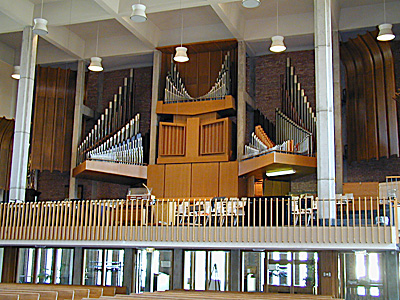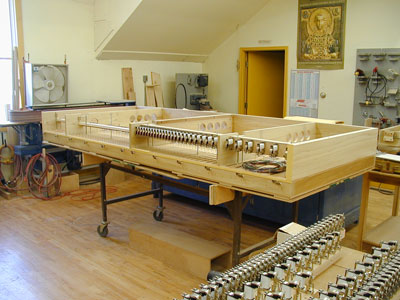 |
|||||||||||||||||||||||||||||||||||||||||||||||||||||||||||||||||||||||||||||||||||||||||||||||||||||||||||||||||||||||||||||||||||||||||||||||||||||||||||||||||||||||||||||||||||||||||||||||||||||||||||||||||||||||||||||||||||||||||||||||||||||||||||||||||||||
 |

Westwood Lutheran Church Renovation of the 1964 Holtkamp Organ
History of the Organ In 1955, Westwood Lutheran Church moved to its present site and embarked on a building program that culminated in the dedication of the current sanctuary in 1963. Before the architects were selected, however, Walter Holtkamp, Sr. was retained as organ consultant in 1959. He met with the building committee and with the first organ committee: Ronald Nelson, director of music; Loraine Langmo, organist; and Corolyn Gaalswyk, of the music committee. Holtkamp recommended that architect and organ builder work together from the very beginning, since the church itself is a part of the organ, and an organ will sound different in different acoustical spaces. The committee, as well as organ students from Westwood, visited churches in the area and played pipe organs of various builders. The Holtkamp Organ Company of Cleveland, Ohio, was selected to build Westwood’s organ. Mr. Holtkamp acted as consultant to architects Sövik, Mathre and Madsen and the acoustical engineering firm of Bolt, Beranek and Newman. Holtkamp was a leading pioneer in the return to classic principles of organ design and placement. He was probably best known for advocating the return of the centuries-old European method of bringing the organ into the room. He believed the tone was impaired if the pipes were placed in the roof and basement of the building. He insisted that organ and choir be placed together here at Westwood. Sadly, Walter Holtkamp died in February of 1962. Westwood’s organ was his last project. His son, Walter, Jr., completed the design and supervised the building of the organ. It was dedicated on May 17, 1964, Pentecost Sunday, at morning services and in afternoon and evening recitals played by Dr. Heinrich Fleischer, University of Minnesota organist. The organ had 40 ranks and 2100 pipes, and cost $50,000. Time and usage have taken a toll on Westwood’s historic treasure. Mechanical repairs, cleaning and technological upgrades were called for in order to ensure that it would continue to serve us well into the next century. A new organ task force began to meet in 1996: Steve Grobe, chair; organist Dr. Kristina Langlois; Jim Halverson; Steve LaBelle; Rod Olson; Richard Steege; Yvonne Thomas; and Marcia Vermedahl. The group began to dream of the possibility of expanding the organ with additional ranks of pipes to enhance the sound, improve the organ’s capability to accompany a full sanctuary on festival days and special occasions, as well as to perform and accompany a wider range of repertoire. The task force met and consulted with David Engen, organist and builder/technician; John Ferguson, St. Olaf College organist/professor and a Holtkamp expert; and Paul Manz, renowned organist, to receive input and recommendations on proposed additions and organ builders. The group, which consisted of several organists, visited and played a number of Holtkamp and Dobson organs in the area, as well as those of other builders. They received proposals from both builders after also meeting with them personally. Dobson Pipe Organ Builders of Lake City, Iowa, was the company selected for the project. They were very conscious of the historic nature of our instrument and of our desire not to compromise its integrity as well as to retain its visual appearance. The “new” organ, when preparations are completed, will contain 52 ranks totaling 2,805 pipes. —Yvonne Thomas
|
||||||||||||||||||||||||||||||||||||||||||||||||||||||||||||||||||||||||||||||||||||||||||||||||||||||||||||||||||||||||||||||||||||||||||||||||||||||||||||||||||||||||||||||||||||||||||||||||||||||||||||||||||||||||||||||||||||||||||||||||||||||||||||||||||||
|
Our Shop • Instruments • Recordings • Testimonials Dobson Pipe Organ Builders, Ltd. Site conception by metaglyph All contents ©1999–2016 Dobson Pipe Organ Builders, Ltd. |
|||||||||||||||||||||||||||||||||||||||||||||||||||||||||||||||||||||||||||||||||||||||||||||||||||||||||||||||||||||||||||||||||||||||||||||||||||||||||||||||||||||||||||||||||||||||||||||||||||||||||||||||||||||||||||||||||||||||||||||||||||||||||||||||||||||




